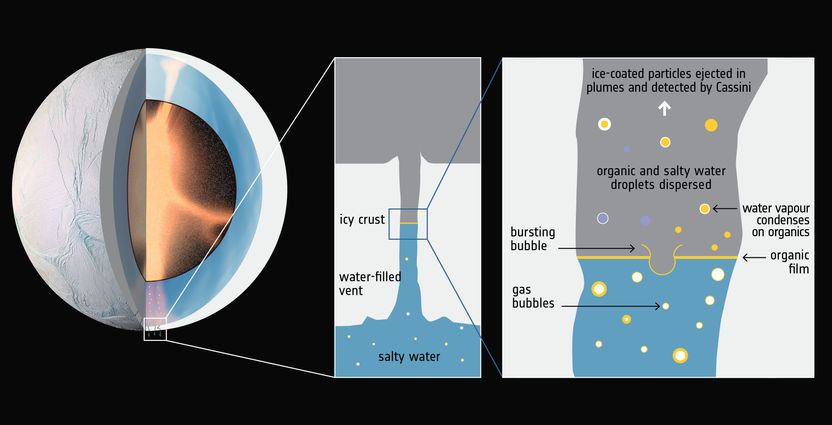Bacteria beyond Earth?
Signs of life detectable in single ice grains emitted from moons orbiting Saturn and Jupiter
The ice-encrusted oceans of some of the moons orbiting Saturn and Jupiter are prime candidates in the search for extraterrestrial life. A new lab-based study led by Freie Universität Berlin and the University of Washington, Seattle, shows that individual ice grains ejected from these planetary bodies may contain enough material for instruments headed there this fall to detect signs of life – if such life exists. “For the first time we have shown that even a tiny fraction of cellular material could be identified by a mass spectrometer onboard a spacecraft,” says lead author Dr. Fabian Klenner, a postdoctoral researcher at the Department of Earth and Space Sciences, University of Washington. Klenner conducted research at Freie Universität Berlin until 2023. “Our results give us more confidence that new, upcoming instruments will soon allow us to detect lifeforms similar to those on Earth, which we increasingly believe could be present on ocean-bearing moons.

ESA
The Cassini mission that ended in 2017 discovered parallel cracks near the south pole of Saturn’s moon Enceladus. Emanating from these cracks is a plume containing gas and ice grains formed from the moon’s subsurface ocean. Scheduled to launch in October of this year, NASA’s Europa Clipper mission will explore Europa, one of Jupiter’s icy moons, in more detail than ever before.
To prepare for this mission, researchers are studying what the new generation of instruments on board Europa Clipper might find. The authors used an experimental setup at Freie Universität Berlin that sends a thin beam of liquid water into a vacuum, where it disintegrates into droplets. They then used a laser beam to excite the droplets and mass spectral analysis to mimic what a mass spectrometer on the space probe will detect.
Newly published results show that instruments slated to go on future missions, like the SUrface Dust Analyzer onboard Europa Clipper, are capable of detecting cellular material, even if this is present in only one out of hundreds of thousands of ice grains.
The study focused on Sphingopyxis alaskensis, a common bacterium in waters off Alaska. Compared to the bacterium Escherichia coli, which many studies use as a model organism, this single-celled organism is much smaller, lives in cold environments, and requires only a few nutrients to survive. These characteristics make it a more suitable candidate for potential life on the icy moons of Saturn or Jupiter.
“These bacteria are extremely small, meaning that, in theory, they could be contained within ice grains emitted from an ocean world like Enceladus or Europa,” says Klenner.
Earlier studies have shown that different compounds from a subsurface ocean separate into individual ice grains when expelled into space. The new research shows that analyzing single ice grains, in which biomaterial may be concentrated, would be a more successful method of identifying life than the practice of averaging across a larger sample containing billions of individual grains.
A recent study led by the same researchers showed evidence of phosphate on Enceladus. This planetary body now appears to contain energy, water, phosphate, and other salts and carbon-based organic material, making it increasingly likely to support lifeforms similar to those found on Earth.
The authors hypothesize that if bacterial cells are encased in a lipid membrane, as found on Earth, then they would also form a skin on the ocean’s surface. On Earth, ocean scum is a key part of sea spray that contributes to the smell of the ocean. On an icy moon where the ocean is connected to the surface (e.g., through cracks in the ice crust), the vacuum of outer space would cause this subsurface ocean to boil. Gas bubbles rise through the ocean and burst at the surface, where cellular material could get incorporated into ice grains within the plume.
“We here describe a plausible scenario for how bacterial cells can, in theory, be incorporated into icy material that is formed from liquid water on Enceladus or Europa and then gets emitted into space,” says Klenner.
The analytical capabilities of the SUrface Dust Analyzer onboard Europa Clipper will be even greater than those of instruments on past missions. For the first time, this and other instruments on board future missions will be able to detect ions with negative charges from ice grain impacts, making them better equipped to detect fatty acids and lipids.
“For me, it is even more exciting to look for lipids, or for fatty acids, than to look for the building blocks of DNA. This is because fatty acids appear to be more stable,” says Klenner.
“With suitable instruments, such as the SUrface Dust Analyzer on board NASA’s Europa Clipper space probe, it might be easier than we thought to find life, or traces of it, on icy moons – that is, of course, if life is present there and cares to be enclosed in ice grains originating from an environment such as a subsurface water reservoir,” says senior co-author Professor Frank Postberg, professor of planetary sciences at the Institute of Geological Sciences at Freie Universität Berlin.
The study was funded by the European Research Council (ERC), NASA, and the German Research Foundation (DFG). The other co-authors are Janine Bönigk, Dr. Maryse Napoleoni, Dr. Jon Hillier, and Dr. Nozair Khawaja (Freie Universität Berlin); Professor Karen Olsson-Francis (The Open University, UK); Dr. Morgan Cable and Dr. Michael Malaska (NASA Jet Propulsion Laboratory, USA); Professor Sascha Kempf (University of Colorado Boulder, USA); and Professor Bernd Abel (Leipzig University, Germany).
Original publication
Other news from the department science
Most read news
More news from our other portals
See the theme worlds for related content
Topic World Mass Spectrometry
Mass spectrometry enables us to detect and identify molecules and reveal their structure. Whether in chemistry, biochemistry or forensics - mass spectrometry opens up unexpected insights into the composition of our world. Immerse yourself in the fascinating world of mass spectrometry!

Topic World Mass Spectrometry
Mass spectrometry enables us to detect and identify molecules and reveal their structure. Whether in chemistry, biochemistry or forensics - mass spectrometry opens up unexpected insights into the composition of our world. Immerse yourself in the fascinating world of mass spectrometry!






















































